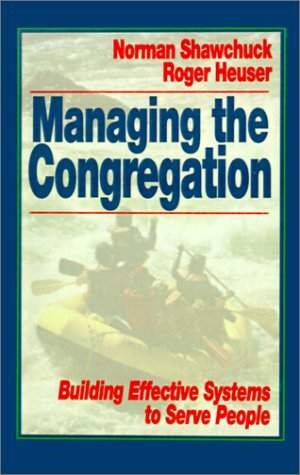Norman Shawchuck and Roger Heuser, Managing the Congregation: Building Effective Systems to Serve People. Abingdon, 1996.
Companion volume: Heuser and Shawchuck, Leading the Congregation
Referenced in:
- Empowering Leadership
- Empowering Ministry Belief Systems and Structures
- Plural-Elder Congregational Leadership
LifeandLeadership.com Summary
This is a good companion to another volume by Shawchuck, Leading the Congregation. Shawchuck has a Ph.D. in organizational systems, a deep awareness of the classic works of spiritual formation, and a keen grasp of churches as emotional/relational systems. The result is a rich integration of spirituality, organizational theory, and systems thinking into a healthy way of leadership being and doing. I have yet to find a better integration for church leaders. I prefer less corporate terminology, but beyond this small caveat, Shawchuck is simply excellent.
The subtitle is a good description of the text. It shows how to “build effective systems to serve the congregation.” Toward that end, I strongly recommend all but the last two chapters, which struggle to translate the concepts of learning organizations and total quality management into congregational life. The first fifteen chapters, however, are gold. Admittedly, they are not practical how-to guides, but offer excellent perspective on how leaders and congregations work together.
The first two chapters focus on the ministers as a manager/steward of oneself and one’s relationship with God. Chapter 2 is especially good in discussing the classic spiritual disciplines for church leaders. This is one of Shawchuck’s strengths that is also reflected in a companion volume, Leading the Congregation, as well as his popular co-authored with Reuben Job, (Guide to Prayer for Ministers and Other Servants (1987)).
Chapter 3 is very technical, but offers an excellent view of how the congregation fits into the larger system of the cultural environment, community, and “sentient boundary” of one’s faith tradition and congregational identity. The most helpful piece of this is the “Transforming System,” i.e. those aspects of congregational life on which a leader must focus in order to effect lasting change. This “systems” understanding is the rubric for the rest of the book. Chapter 4 discusses in more detail the effect of the environment, surrounding community, and other boundaries that define a congregation’s essential identity. The next three chapters look more specifically at the elements of congregational life that have the most transforming effect on a congregation’s mission capacity, such as mission (chapter 5), vision (chapter 6), and spirit (chapter 7).
Part 4 (Chapters 8-10) is my favorite part of the book, providing an excellent conceptual framework for how congregations either block, channel, or scatter their energy toward effective mission. The essential key is for the leaders to operate from belief systems and out of structures that are empowering vs. bureaucratic and paternalistic. An integral part of such a healthy system is the perspective of partnership, which is discussed in chapter 10.
Part 5 (chapters 11-14) takes up the issue of the congregation’s relationships, suggesting a “relational systems” view that is similar to that of Ed Friedman, Pete Steinke, and Margaret Marcusson. This also includes good insights into how leaders view people, wield power, manage conflict, and deal with anxiety.
Many leaders will not want to wade through the theoretical and technical language of this text, but those who do will be changed significantly for the better.
From the Publisher
The third volume of Shawchuck and Heuser’s trilogy, this title will focus on the relationships and processes common to the religious congregation. The emphasis will be on the identification and maximization of effective processes within church structures.
Key Features: Detailed analysis of the congregation as a network of systems and relationships; Explores four areas of potential transformation for the congregation: mission, spiritual formation, relationship with people, and structures of ministry; Comprehensive format ideal for pastors and seminary students.
Key Benefits: Identifying systems and relationships within the congregation enables church leaders to be intentional and structured in their approach to change; Emphasizes the concept of the “Continuous Improvement Project,” which helps leaders to understand the on-going nature of organizational transformation; Contributes to our understanding of how to design, implement, or change systems within the congregation in order to enhance the effectiveness of ministry.
About the Author
Norman Shawchuck is a teacher and consultant at Vanguard University of Southern California. He is the president of Shawchuck & Associates, Ltd. He has worked and taught in Korea, Indonesia, Egypt, and Israel. He has consulted with more than two dozen denominations and other church organizations, and has trained U. S. Navy and Marine military chaplains in North Dakota, Illinois, and Indiana. His Ph.D. in systems theory is from Northwestern University.
Roger Heuser is a Professor of Church Leadership Studies at Southern California College in Costa Mesa. He is widely known in the West as a management consultant and trainer in evangelical and mainstream Protestant churches and organizations. He previously pastored Assembly of God churches in Illinois. His Ph.D. in management is from New York University.
***For additional information on this resource, including reviews, click the bookstore links. Check the reference at page top or the links below for resource guides on related topics.***
See Related Ministry Resources:
See Resources on Over 100 Areas of Ministry Leadership:


